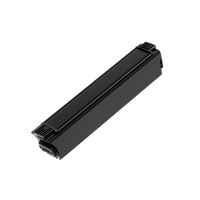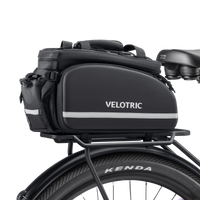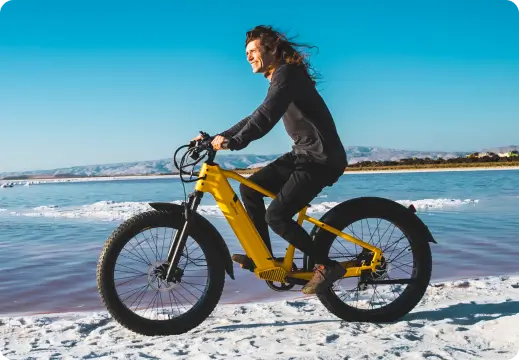Washington is one of the more ebike-friendly states in the U.S., with clear rules that make it easier for riders to understand where and how they can legally ride. Whether you're commuting, exploring bike trails, or cruising city streets, knowing the state’s electric bike regulations helps ensure a smoother and safer ride.
Below is a simple breakdown of Washington’s current ebike laws and what they mean for riders in 2024–2025.
What’s legally considered an ebike in Washington?
To be legally considered ebikes in Washington, bikes need to have a seat, operable pedals, two to three wheels, and an electric motor that can have a power output of up to 750 watts. There are three classes of ebikes: Class 1, Class 2, and Class 3. We’ll go into detail on these later.
Ebike motors are designed to assist until the bicycle reaches a speed of no more than 28 miles per hour (mph). Once the bike reaches the top speed, the motor stops working.
Generally, electric bicycles have labels from the manufacturer that show their classification number, motors’ power, and top assisted speeds. If you alter your bike to go faster, you must replace the label to reflect the new top speed.
Ebike laws in Washington
Washington’s state laws treat ebikes a lot like bicycles, but there are a few differences. We’ll get into some of the ebike laws in Washington.

Where are you allowed to ride ebikes in Washington?
Washington offers a wide network of bike lanes, shared-use paths, and multi-use trails. Most allow ebike access, but the permitted class may vary.
Bike Lanes & Roadways
- Class 1, 2, and 3 ebikes are all allowed unless posted otherwise.
- Local jurisdictions may impose restrictions in high-traffic or pedestrian-heavy zones.
Shared-Use Paths
- Class 1 and Class 2 are generally permitted.
- Class 3 may be restricted on some paths due to speed limits.
Cities such as Seattle, Spokane, Bellevue, and Tacoma may have additional rules, so checking local guidelines is recommended.
State Parks & Natural Areas
Regulations vary by park. Many state-managed parks allow Class 1 ebikes where standard bikes are allowed but require review for Class 2 and 3 usage.
What class of ebikes are legal in Washington?
Washington follows the standard Class 1, Class 2, and Class 3 ebike system, so riders, retailers, and local enforcement all share the same definitions:
- Class 1: Pedal assist only, motor stops at 20 mph
- Class 2: Throttle or pedal assist, up to 20 mph
- Class 3: Pedal assist only, up to 28 mph
Class 3 ebikes must have speedometers, and they’re restricted in some areas that allow Class 1 and Class 2 bikes. Many states also have minimum age requirements for Class 3 ebike riders.
All ebikes must have a motor of 750W or less, which aligns with federal guidelines. This classification system determines where each ebike can be ridden across the state.
How old do you have to be to ride an ebike in Washington?
Anyone can ride a Class 1 or Class 2 ebike in Washington, but bicyclists who ride Class 3 ebikes must be at least 16 years of age.
Do you need a helmet when riding an ebike in Washington?
States make their own bicycle helmet laws. Some states, like Oregon, have helmet laws for young cyclists. Other states let local authorities make helmet laws. Washington’s localities create their own laws for ebikes of all classes.
It’s pretty difficult to fairly police helmets. In fact, King County, which includes Seattle, recently dropped its helmet mandate (in effect since 1993). But just because there’s no law making you wear a helmet doesn’t mean you shouldn’t wear one.
It’s really important to protect your noggin. Check out our helmet guide for tips on finding a great helmet.

Do you need a license to ride an ebike in Washington?
Electric-assisted bicycles can save you money in insurance fees over motor vehicles. You don’t need a driver’s license or insurance to use an ebike in Washington. As long as your ebike fits within the Class 1/2/3 system and 750W limit, you can ride legally without DMV involvement.
Local ordinances for ebikes in Washington
While Washington law sets consistent statewide guidelines, local municipalities may add rules about:
- Speed limits on shared trails
- Ebike use in city-managed parks
- Specific beachfront or waterfront path restrictions
- Trail usage during busy season or events
If you ride regularly in Seattle, Redmond, Bellingham, or Bellevue, it’s helpful to confirm local city codes before heading out.
What you should know before riding your ebike in Washington
If you’re planning an ebike trip to Washington, you won’t be disappointed. There are plenty of places to ride. Take a ferry to Bainbridge Island, see historical landmarks on the Centennial Trail, or peek at the wildlife from the bike lanes of the Lake Washington Loop.
Just make sure you know the rules of the road. Check with local or state land managers or the U.S. Forest Service (for public lands) and do a quick online search to see if any ordinances restrict ebikes in the area.
Experience a Velotric ebike in Washington
Now that you’ve found the perfect Washington trail to explore, you only need the right ebike. Velotric has some excellent models.
The Discover 2 has a sleek design and an energy-efficient 750/1100W rated/peak motor designed to help you weave through the city. It can go up to 75 miles on a single charge.
The lightweight urban electric bike T1ST Plus, weighing just 38 lbs and featuring an ergonomic design, was named CNET's Best Electric Bike of 2025. Its sleek appearance and 70-Miles range on a single charge make it the ideal choice for riding in Washington.
Summary
Washington’s ebike laws are clear, practical, and rider-friendly. With straightforward classifications and broad access to bike lanes and shared-use paths, the state makes it easy for riders of all experience levels to enjoy electric bikes safely.
Whether you’re commuting or exploring Washington’s trail networks, knowing the rules helps you stay protected while maximizing your riding experience.
Data Sources
The above information is sourced from these websites and was last updated in November 2025. If you have any questions, you can visit the following sites directly for confirmation.


































